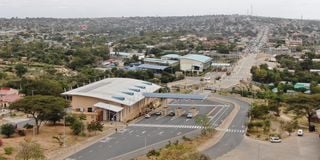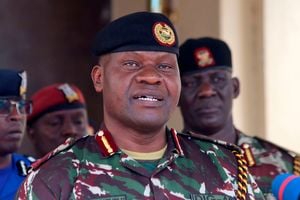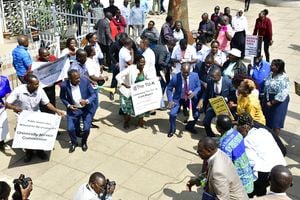Nomads at War: What’s driving insecurity at the Kenya-Ethiopia border

Aerial view of Moyale One Stop Border Point. COMESA has announced plans to modernize the facility to boost its full operations.
Communal conflict is endemic in the vast arid region on both sides of the Kenya-Ethiopia border. Fresh alarm has been sparked in both countries following a kidnapping and armed attacks on police and civilians in Kenya’s Marsabit county, in the extreme north of the country. Oscar Mwangi Gakuo, who has studied the roots of conflict in the border region, sets out the context.
What is the history of the tensions along the Kenya-Ethiopia border?
Marsabit County is Kenya’s largest, covering an area of of 70,961 square kilometres. This is roughly equivalent in size to Sierra Leone or the combined size of Rwanda, Burundi and Eswatini.
It is one of the four Kenyan counties bordering Ethiopia.
Situated in the Chalbi Desert belt, the county is mostly arid and semi-arid. The people who live there are mainly herders who move from place to place to graze livestock. Poverty levels are high and conflict over resources erupts frequently.
In July 2005, animosities between the majority Borana and Gabra communities led to the killing of 95 people in what became known as the Turbi Massacre.
The hostilities also have cross-border dimensions. The borderlands harbour armed rebel groups such as the Oromo Liberation Army, which has roots in northern Kenya and southern Ethiopia.
Daily acts of violence in this remote region rarely catch national attention. But the highest levels of state security took notice in both Kenya and Ethiopia following the latest attacks. They are perceived to involve the Oromo Liberation Front and the Somalia-based Al-Shabaab group, raising concerns about transnational terrorism.
This frontier region is fragile. State institutions are weak and don’t provide citizens with minimum levels of security and well-being. Inter-ethnic conflicts among nomad pastoralists have led to the proliferation of small arms.
Security failures also stem from the fact that Kenyan and Ethiopian security policies don’t work together. For example, the Kenyan government strictly controls the licensing of weapons to civilians. But in Ethiopia civilians are permitted to own arms if they register with the federal government. Kenyans in the northern frontier region can still get illicit arms for self-defence and cross-border incursions.
The government’s efforts to disarm pastoralists are often futile because of the porous border.
What are the main drivers of insecurity in the region?
Conflicts in Marsabit are driven by scarce natural resources as well as ethno-political and cultural disputes.
Several related factors include:
competition for grazing areas and water resources, owing to climate change and environmental degradation
- political devolution, ethnicity, local politics and elections
- militarisation of ethnic groups and nonstate armed groups
- large numbers of small arms and light weapons.
Resource-based conflicts arise over conflicting claims of ownership of grazing areas and water resources, especially during dry seasons. Conflicts between communities and the state also occur around protected areas such as national parks during dry seasons.
Another contributing factor to the violence is the way in which the region is governed.
Kenya has decentralised several state functions to the counties. But security governance remains centralised under the national government.
This top-down approach has left county governments feeling alienated.
New administrative boundaries have been created in Marsabit. This has worsened inter-ethnic conflicts between the Borana and Gabra over resources. Adding to the toxic mix is that both groups have militias which state security agencies have labelled as “bandits”.
There is also competition for new political and administrative positions.
The region is affected by the broader political atmosphere in Kenya, too. Conflicts are rife, fuelled by debates and differences being framed along ethnic lines. In particular, the country’s political elite focuses on the historical differences among ethnic groups and resource competition. This happens particularly during electoral periods. The result is the promotion of intolerance, suspicion, distrust and fear among ethnic groups.
What are the cross-border threats?
The Borana and Gabra communities share a common socio-cultural history with the Ethiopian Oromo. The communities belong to the larger linguistic Oromia community, which spans both countries.
Despite the shared culture, cross-border conflicts occur between the communities.
Cross-border incursions by Ethiopian forces and the Oromo Liberation Army also heighten inter-state tensions. The Oromo Liberation Army fights the Ethiopian government in Oromia, especially in the western and southern parts of the region. Its aim is self-determination for the Oromo ethnic peoples.
The Oromo Liberation Army, also known as the Oromo Liberation Front (OLF)-Shane, was originally the military wing of the Oromo Liberation Front party. It split from the party in April 2019.
Ethiopian armed forces are known to cross the Kenyan border in pursuit of Oromo fighters. The government in Addis Ababa regards them as terrorists. In November 2021, residents of the border town of Moyale in Kenya accused Ethiopian troops of crossing the border, looting neighbourhoods and taking away civilians accused of sheltering Oromo Liberation Army insurgents.
A month after the 2021 incursion by Ethiopian troops, Prime Minister Abiy Ahmed visited the Kenyan side of the border with Kenya’s President Uhuru Kenyatta. Abiy claimed then that the Oromo Liberation Front had an alliance with al-Shabaab. He called for both to be “eliminated”.
Since 2010 Kenya and Ethiopia have shared intelligence on the Oromo Liberation Front, resulting in arrests and deportations. But the Oromo Liberation Front has in the past emphasised that stirring up ethnic conflict between the Borana and Gabra communities along the Kenya-Ethiopia border is a counterinsurgency technique by Ethiopian governments to discredit it.
Ethiopian officials have claimed that the Oromo Liberation Front and the Somali-based jihadist group, al-Shabaab, work together. However, there is no substantial evidence to support this.
Oscar Gakuo Mwangi is Associate Professor of Political Science at the University of Rwanda.





